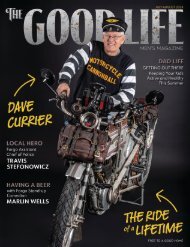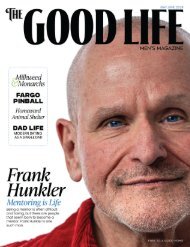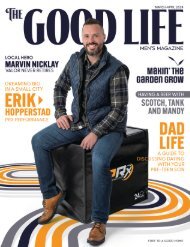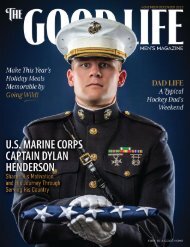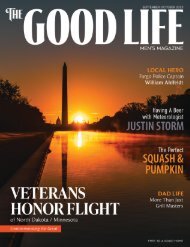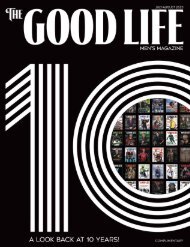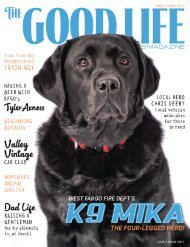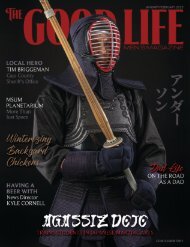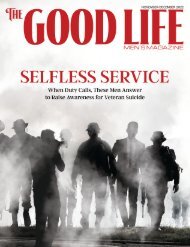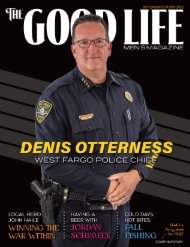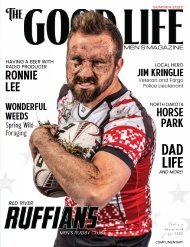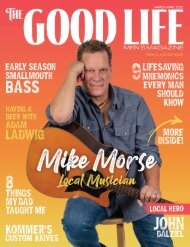The Good Life – July-August 2015
Fargo Moorhead's premier men's magazine. Featuring the ultimate outdoorsman Bret Amundson, the Hot Rod Shop of Fargo, FC Fargo Soccer Team, Prairie Rose Meadery, Fathers, Local Heroes - Red River Regional Dispatch and more!
Fargo Moorhead's premier men's magazine. Featuring the ultimate outdoorsman Bret Amundson, the Hot Rod Shop of Fargo, FC Fargo Soccer Team, Prairie Rose Meadery, Fathers, Local Heroes - Red River Regional Dispatch and more!
You also want an ePaper? Increase the reach of your titles
YUMPU automatically turns print PDFs into web optimized ePapers that Google loves.
3
OVERSTAYING<br />
YOUR WELCOME<br />
Learning How to Kick Yourself Out First<br />
BY: MEGHAN FEIR<br />
t<br />
here is a fitting time and<br />
place for overstaying your<br />
welcome. <strong>The</strong> time: never.<br />
<strong>The</strong> location: nowhere.<br />
Whether you are the unwelcomed<br />
party or the frustrated host held<br />
hostage, read on, my frustrated<br />
friends.<br />
<strong>The</strong> Unwelcomed<br />
Where you lack in social cues, you<br />
thrive in your ability to annoy. You<br />
are the guest, much to the chagrin of<br />
the wearied hosts, and you somehow<br />
grew up with no social intuition.<br />
Never fear, though. You, old dog, can<br />
learn a new trick or two by the time<br />
you have finished reading this article.<br />
Notice I chose the word “reading,”<br />
not “grazing.” Take this message to<br />
heart, for your own sake and the sake<br />
of others.<br />
Whenever you hear the other guests<br />
uttering, “Welp, I think we’d all<br />
better head out,” follow the crowd.<br />
Make a dash for your car as if the<br />
clock has struck midnight and your<br />
Ford is about to turn back into a<br />
pumpkin.<br />
If the host is remarking on how<br />
tired they are, how early they have<br />
to rise the next day and that they are<br />
moments away from retiring for the<br />
evening, take it as a sign that you have<br />
already overstayed your welcome and<br />
must leave in haste.<br />
Do not let it get to the point of the<br />
host having to bluntly state, “You<br />
need to leave.” I have had to do<br />
2
this before to one oblivious or<br />
stubborn guest after I had tried<br />
all other means. My other friends<br />
had long gone. I told the lingerer I<br />
was tired. I told them my eyes were<br />
involuntarily closing from fatigue.<br />
I told them a great many things<br />
before resorting to the bluntness<br />
of “You need to leave,” and even<br />
after I uttered those words, it still<br />
took them another 30 minutes<br />
before they finally left.<br />
<strong>The</strong> importance of heeding (and<br />
actually noticing) social cues boils<br />
down to consideration. Take the<br />
time to think of the other person<br />
and their situation. I’m not in the<br />
habit of encouraging anyone to<br />
be prideful, but, in this case, have<br />
a little pride. Don’t embarrass<br />
yourself and your host by being<br />
the pest that incessantly buzzes<br />
around their head. A good thing to<br />
consider throughout the evening<br />
is whether or not they should ever<br />
want to invite you over again.<br />
For the Frustrated<br />
Do you consider yourself “too<br />
nice” to say anything as blunt as<br />
“Well, I suppose you’d better go,”<br />
calling off all the dilly-dallying<br />
and getting to the point? Just stop.<br />
Buck up and realize you are a<br />
grown man and have no right to<br />
act like a shy, passive-aggressive<br />
11-year-old boy. Telling the rest<br />
of your friends how annoying<br />
your unwelcomed guest was is the<br />
reason the term “Minnesota nice”<br />
has been tainted.<br />
Being assertive does not equate<br />
meanness. Would you rather<br />
someone be upfront and honest<br />
to your face or have them tell your<br />
friends and their children what a<br />
moron you were the evening you<br />
wouldn’t leave their doorstep?<br />
You can be tactful and assertive,<br />
honest, yet kind.<br />
3
CONTENTS<br />
JULY-AUGUST <strong>2015</strong> | VOLUME 3 • ISSUE 1<br />
ON THE COVER<br />
18 BAD TO THE T-BONE<br />
AMUNDSON ENJOYS THE OUTDOORS<br />
FROM MINNESOTA TO ARGENTINA<br />
IN THIS ISSUE<br />
02 OVERSTAYING YOUR WELCOME<br />
Learning How to Kick Yourself Out First<br />
06<br />
08<br />
12<br />
16<br />
24<br />
26<br />
30<br />
CAR CARE<br />
How to Choose an Automotive Service<br />
Center<br />
FUTBOL IN FARGO<br />
FC Fargo Soccer Team Set to Make Its Debut<br />
HANGING OUT AT THE HOT ROD SHOP OF<br />
FARGO<br />
Local Hot Rod Guru Cody Wendelbo Shows<br />
<strong>The</strong> <strong>Good</strong> <strong>Life</strong> Around the Shop<br />
HAVING A BEER WITH ...<br />
Dave Piepkorn<br />
FATHERS<br />
10 Things to Teach Your Son About Manhood<br />
THE PRAIRIE ROSE MEADERY<br />
<strong>The</strong> Bees Should Know<br />
LOCAL HEROES<br />
Help is on the Way - How the Red<br />
River Regional Dispatch Center Keeps<br />
Communities Safe<br />
12 16<br />
4
PUBLISHED BY<br />
Urban Toad Media LLP<br />
www.urbantoadmedia.com<br />
CREATIVE DIRECTOR<br />
Dawn Siewert<br />
dawn@urbantoadmedia.com<br />
PHOTOGRAPHY<br />
Darren Losee<br />
darren@urbantoadmedia.com<br />
CONTRIBUTING WRITERS<br />
Soo Asheim<br />
Jessica Ballou<br />
Meghan Feir<br />
Paul Hankel<br />
Matt Lachowitzer<br />
Danielle Teigen<br />
ADVERTISING INQUIRIES<br />
dawn@urbantoadmedia.com | 701-388-4506<br />
darren@urbantoadmedia.com | 701-261-9139<br />
18<br />
08<br />
FOLLOW URBAN TOAD MEDIA<br />
ON TWITTER & FACEBOOK<br />
READ AN ISSUE ONLINE:<br />
issuu.com/thegoodlifemensmag<br />
<strong>The</strong> <strong>Good</strong> <strong>Life</strong> Men’s Magazine is distributed six times a year by<br />
Urban Toad Media LLP. Material may not be reproduced without<br />
permission. <strong>The</strong> <strong>Good</strong> <strong>Life</strong> Men’s Magazine accepts no liability for<br />
reader dissatisfaction arising from content in this publication. <strong>The</strong><br />
opinions expressed, or advice given, are the views of individual<br />
writers or advertisers and do not necessarily represent the views or<br />
policies of <strong>The</strong> <strong>Good</strong> <strong>Life</strong> Men’s Magazine.<br />
5
Car Care<br />
How to Choose an Automotive Service Center<br />
BY: MATT LACHOWITZER<br />
No one likes to think about needing an automotive service center, but selecting a good one is like<br />
having good health insurance: you hope you never need it, but you have it “just in case.” When it<br />
comes to cars, all vehicles require service or repairs eventually. You could even say there are three<br />
things that are certain in life: taxes, death, and vehicle repairs, and having an existing relationship with<br />
an automotive service center will save time and hassle when your vehicle needs maintenance or an<br />
immediate repair. If you’re not sure how to build a good working relationship with a service center,<br />
try taking your vehicle in for regular maintenance; a well-cared for vehicle will run longer and more<br />
smoothly, as well as incur lower operating and service costs.<br />
Some things to keep in mind when searching for an automotive service center:<br />
• Less than 40 percent of new automotive service center customers are walk-ins. Most people are<br />
referred by friends, relatives, or co-workers. If you haven’t received any recommendations, make<br />
sure you ask your prospective auto service center for references.<br />
• If you travel often, look for an automotive service center that stands behind their work with a<br />
nationwide warranty. For instance, a warranty of 12 months or 12,000 miles will give you peace of<br />
mind. Some centers even offer 2 years or 24,000 miles or 3 years or 36,000 miles. Some also offer<br />
road side assistance such as: towing, flat tire changing, fuel delivery, and lock outs for a certain time<br />
after services or repairs have been done complimentary.<br />
• Check the service<br />
centers range of services<br />
and whether the center has<br />
the latest technologies to<br />
properly test, diagnose, and<br />
repair problems with newer<br />
vehicles. For example, can<br />
your prospective service<br />
center handle brake systems,<br />
electrical components,<br />
transmission repairs, or dealer<br />
level services? Do they provide<br />
a loaner, rental car, or shuttle<br />
service while your vehicle is<br />
being serviced or repaired?<br />
6
• Look for a good<br />
customer satisfaction<br />
policy, equipment in good<br />
condition, bright lighting,<br />
cleanliness in the waiting,<br />
restroom, shop areas,<br />
and general organization.<br />
Also look for the centers<br />
commitment to the<br />
community such as awards<br />
or plaques for sports teams,<br />
benefits, etc. Also check to<br />
see how long the service<br />
center has been around and<br />
take notice to how you were<br />
treated whether in person or<br />
over the telephone. <strong>The</strong>se<br />
factors all contribute to the<br />
level of professionalism,<br />
gaining customers trust, and<br />
to optimal service. In today’s<br />
world, the internet is a<br />
powerful tool. Do a Google<br />
search on the automotive service center you are interested in visiting, read their reviews, how they<br />
respond to positive and negative feedback, and also visit their website and social media pages. Drive<br />
by the center and look at other types of vehicles in their lot; are they similar to yours? Are they newer<br />
vehicles or are they old run down vehicles? <strong>The</strong>se are invaluable tools you can use to help make an<br />
informed decision on which service center you choose.<br />
• Look for brand names such as ACDelco and Certified Auto Repair. <strong>The</strong>se names are associated<br />
with brand name parts that are engineered to meet the manufacturer’s specifications and will likely<br />
come with a warranty that is much better than off-brand parts.<br />
• Is the business associated with the Automotive Service Association (ASA), Alliance of Automotive<br />
Service Providers (AASP), Angie’s List, or the Better Business Bureau? Are the technicians and staff<br />
certified by a specific auto manufacturer or by Automotive Service Excellence (ASE)? If so, this<br />
indicates a higher customer approval rating and the ability to adequately perform and stand behind<br />
the services they advertise.<br />
• Whether you are considering a big name franchise or an independently owned service center,<br />
compare the usual services and fees of each center to familiarize yourself with the average price<br />
ranges.<br />
• Don’t select a service center based solely lower prices; shoddy service or poor quality parts can<br />
mean more repairs and higher costs in the long run.<br />
After you have chosen a center, try to establish a good working relationship with<br />
the staff. Since your vehicle needs preventative maintenance anyway, take it to<br />
your new service center for a trial run and have a simple service such as an oil<br />
service or air conditioning check performed. Some services may be offered free<br />
of charge; these services can provide you with a good idea of the service you<br />
will need, and the service you will receive. And most of all, ASK questions! <strong>The</strong><br />
more you know and understand what is going on with your vehicle and why it is<br />
needed, the better decisions you can make for you and your vehicle.<br />
7
8
BY: PAUL HANKEL | PHOTOS: URBAN TOAD MEDIA<br />
A ONE ON ONE CHAT WITH TIM SINGLETON,<br />
THE OWNER OF FARGO’S NEWEST SPORTS TEAM.<br />
With summer in full swing, <strong>The</strong> <strong>Good</strong> <strong>Life</strong> caught up with Tim Singleton, soccer<br />
fanatic and owner of FC Fargo, to chat about the new team, his players and his<br />
goals for the team, and soccer as a whole in Fargo-Moorhead.<br />
<strong>The</strong> <strong>Good</strong> <strong>Life</strong>: Tell us a little bit about yourself and your soccer background.<br />
Tim Singleton: When I was younger, I studied abroad in Germany and that’s how I fell<br />
in love with soccer. I also played and coached recreationally. Before this, I worked for the<br />
Minnesota United soccer team, back when they were called the Minnesota Stars.<br />
GL: You’ve played, coached and worked behind the scenes. How did you end up owning a team?<br />
TS: Eventually, it came to the point where I could either get a job working for a team from afar,<br />
such as the team in Des Moines, or I could start my own team. Honestly, I started FC Fargo using<br />
Twitter, and as it took off, we incorporated!<br />
GL: How did you decide on Fargo as the location to put your team?<br />
TS: To begin with, I really only look at four places. I looked at the twin cities, Rochester, Duluth and<br />
Moorhead. I was pretty much going to stay in Minnesota, but once I looked at the metro area of Fargo-<br />
Moorhead, I liked the Fargo side better and here we are!<br />
Singleton went on to explain that the ‘soccer scene,’ in the Fargo-Moorhead area is one that is prevalent and<br />
continues to grow. This is evidenced by the fact that some eighty local and regional players tried out for the team.<br />
TS: Soccer is generally seen as a sport you play through high school. If the players want to keep playing, what are<br />
their options? Possibly find a Division 1 or Division 2 school? I think a lot of people view it as a kids sport. I would<br />
like to give players a chance to play quality, competitive soccer, and to have a chance to get signed to a bigger<br />
team. This team will give these players that chance to get noticed.<br />
GL: Why do you think there is such a drop off in soccer participation numbers, once players hit high<br />
school?<br />
TS: I think it’s because of the fact that soccer and American football are played at the same time. I’ve<br />
always said, America would be the best in the world at soccer if our best athletes played soccer. But<br />
Lebron James doesn’t play soccer! Calvin Johnson would make a great goalie. Could you imagine<br />
‘Megatron’ out there blocking shots?! I think the problem is that players are forced to choose<br />
which sports to play, and football gets all the coverage.<br />
GL: Where do most of your players come from?<br />
TS: We had players come from as far as Des Moines, most colleges around here, and<br />
9
throughout the region. Of the<br />
27 on the roster, I would say that<br />
15 are American and 12 are foreign<br />
players who live in this area now.<br />
OUR GOAL IS TO<br />
EVENTUALLY JOIN THE<br />
NORTH AMERICAN SOCCER<br />
LEAGUE, WHICH IS WHERE<br />
MOST OF TODAY’S MAJOR<br />
LEAGUE SOCCER TEAMS<br />
COME FROM.<br />
— TIM SINGLETON, OWNER<br />
GL: What will be the biggest challenge<br />
for your players, in regards to transitioning<br />
from high school and college soccer, to your<br />
team’s level of competition?<br />
TS: I think the biggest challenge will be the<br />
difference in the speed of the game.<br />
GL: Are your players compensated for playing?<br />
TS: Because a lot of the players on the team are college<br />
players, we are not allowed to give them a paycheck.<br />
But we are allowed to cover some of their expenses, food<br />
on the road, lodging and transportation.<br />
GL: What soccer league will FC Fargo be a part of?<br />
TS: We are not a part of a league this year, but next year we will<br />
be joining a league called ASL2, the American Soccer League. It’s<br />
a professional soccer league that is primarily out east, but they are<br />
trying to expand to the Southeast and the Midwest. ASL2 is a league<br />
that specifically tailored to college players.<br />
GL: As the team grows, will you join a bigger league?<br />
TS: Our goal is to eventually join the North American Soccer League, which<br />
is where most of today’s Major League Soccer teams come from.<br />
FC Fargo will be coached by Tommy Nienhaus. <strong>The</strong> first season for FC Fargo<br />
will run June through <strong>July</strong>. Singleton ideally wants his team to play 12 games per<br />
season, 6 home and 6 away. <strong>The</strong> games will be played at the Shanley soccer fields,<br />
where the team will also practice, along with some practices being held at Cheney<br />
Middle School and the Pepsi Soccer Complex. <strong>The</strong> team will hold three practices per<br />
week.<br />
GL: Where do you see FC Fargo in five years?<br />
TS: We’d love to have a reserve team and a women’s team. That would be great.<br />
GL: What would be the ultimate accomplishment for you, as an owner and<br />
a soccer fan?<br />
TS: I would really like to see one of the guys that play for our club end up<br />
playing in Major League Soccer. That would be phenomenal.<br />
For more information about the FC Fargo soccer club, fans can visit<br />
www.fcfargo.com for a game schedule, team bios and more. Fans<br />
can also follow the team on Twitter and Facebook.<br />
10
11
BY: PAUL HANKEL | PHOTOS: URBAN TOAD MEDIA<br />
the owner<br />
Wendelbo, the owner of <strong>The</strong> Hot Rod Shop of Fargo, is no<br />
stranger to cars and has been around them his entire life.<br />
“We always had cars growing up. My mom was the real<br />
hot rodder in the family, and my dad was mechanically<br />
inclined. Fixing cars in the garage was always something<br />
that happened.” Said Wendelbo, “My grandpa owned a gas<br />
station in Langdon and so, during the summers, I’d always<br />
get to go up there and hang out with him and learn.”<br />
12<br />
the market<br />
<strong>The</strong> custom hot rod market is booming and, with purchase<br />
prices for the most sought after and desirable models<br />
soaring into the millions, it’s easy to see why. <strong>The</strong> industry,<br />
including buyers, sellers, custom hot rod shops like <strong>The</strong> Hot<br />
Rod Shop of Fargo, has seen an influx of hot rod enthusiasts,<br />
eager to either customize a hot rod. Wendelbo explained<br />
that newer hot rodders are naturally tending to gravitate<br />
towards newer model cars to customize. “Now we’re seeing
a trend of guys who do pickups and muscle cars. <strong>The</strong>se are<br />
cars that they drove as their high school car or first car; it was<br />
nothing but junk back then, but now I want to have it in my<br />
driveway.” <strong>The</strong> boring, non-exciting explanation for the hot<br />
rod boom can, most likely, be attributed to a slight upswing<br />
in the economy, lower, if not stable gas prices and the everincreasing<br />
desire for rare or one-of-a-kind custom hot rods.<br />
<strong>The</strong> more altruistic explanation: Americans have, and always<br />
will, a passion for nostalgia and muscle cars.<br />
the shop<br />
<strong>The</strong> Hot Rod Shop, opened in 2007, can be found at 1613 1st<br />
Avenue North, in Fargo. <strong>The</strong> shop, itself, is close to 10,000<br />
square feet and, according to Wendelbo, is more than large<br />
enough to accommodate their many ongoing projects. <strong>The</strong><br />
shop has its own metal fabricator, three separate work areas,<br />
a full staff of trained mechanics, and a convenient location<br />
in north Fargo. According to Wendelbo, “We’ve got some<br />
options to expand on this property and I really like being<br />
centrally located in Fargo. Anyone can find us and anyone<br />
can stop by! It’s good for the customers.”<br />
the cars<br />
<strong>The</strong> Hot Rod Shop is a full service custom hot rod shop, and<br />
caters to pretty much anything old, collectible, and need of<br />
some repair work. “We’ll do anything from the 1920’s to the<br />
13
late 1970’s, early 80’s. It’s crazy what you’ll find in some<br />
people’s garages! Every once in a while, we’ll get some<br />
kind of new corvette or something that someone wants to<br />
make look a little nicer, “said Wendelbo, but their bread<br />
and butter is the classics. <strong>The</strong> shops projects have come<br />
from all over the region, even as far away as Dickinson,<br />
North Dakota. Take a tour of the shop and you’ll run into<br />
everything from a more modern Jeep, getting a custom<br />
interior, to an early 1930’s truck, getting a complete<br />
overhaul.<br />
the good life<br />
Wendelbo is one of the rare few people that get to go to<br />
work every day and do a job that truly brings joy to their<br />
life. “I’m lucky enough that my passion is my job. This is<br />
what I did growing up and I was able to turn it into my life<br />
14<br />
and my income. So that’s my good life. I get to be around<br />
hot rodders everyday and enjoy my passion.”<br />
Along with doing what he loves, Wendelbo tries to inspire<br />
the next generation of young hot rodders. “We always try<br />
to have one or two younger guys that are going to be able<br />
to learn hot rodding. That’s always my biggest fear: what<br />
happens when this generation goes away? What types of<br />
cars will be hot rodded? We need these young guys.”<br />
When they’re not busy restoring history, Wendelbo and his<br />
staff at <strong>The</strong> Hot Rod Shop can be found at many of the<br />
local car shows, including the Fargo and West Fargo Cruise<br />
Nights. Anyone interested in getting some work done on<br />
their classic or collectible can come by the shop, call their<br />
office or visit their website at www.hotrodshopoffargo.com.
15
BY: MEGHAN FEIR | PHOTOS: URBAN TOAD MEDIA<br />
He’s a Fargo city commissioner, small-business owner of TruGreen<br />
lawn care service, husband, father of two sons, and a former<br />
NDSU Bison football player, but you probably already know all of<br />
that about Dave Piepkorn.<br />
I had the pleasure of meeting up with Piepkorn at Drekker<br />
Brewing Company in downtown Fargo where he, as the<br />
headline suggests, had a beer, and I had a root beer (much<br />
more exciting than my usual water on the rocks).<br />
With his gregarious personality and contagious passion for<br />
city development, sports and even bald eagles, Piepkorn<br />
is the definition of “a guy you’d like to have a beer with.”<br />
He answered peculiar questions with surety, grace and<br />
good spirit, questions that no one previously cared to<br />
wonder but will enjoy finding out.<br />
GL: If you had to write a greeting card for<br />
Hallmark, what holiday/topic would it be<br />
for and what would it say?<br />
DP: Seriously, whoever came up with<br />
that question…<br />
GL: I came up with all of these questions.<br />
DP: That’s way too deep of a<br />
question. No, seriously, I have to<br />
pass. That’s way too hard. You<br />
should’ve given me that with<br />
a week to think about it, and<br />
it still would’ve been a bad<br />
answer. I’m sorry.<br />
GL: Can you do any<br />
wildlife calls, like loons?<br />
DP: No, I can do this,<br />
though. This is a<br />
loon, isn’t it? (He<br />
then demonstrated<br />
the proper loon-calling<br />
form with his hands and<br />
made a hoot.) We have<br />
loons on our lake. I love<br />
those. I’m a little bit of a<br />
bird person. I could sit<br />
16
Not your everyday interview<br />
<strong>Good</strong> <strong>Life</strong>: I’m going to apologize in advance for all<br />
the strange questions I’m about to ask you. <strong>The</strong>y may<br />
be things you have never been asked or thought of<br />
before. Are you nervous?<br />
Dave Piepkorn: No, not at all. But the one thing I will<br />
say is that I try to be honest.<br />
GL: If Batman and Spiderman were arm wrestling,<br />
who would win and why?<br />
DP: I’d have to go with Batman. Spiderman has webs,<br />
so he could maybe distract Batman. But I think at the<br />
end of the day, I’d have to go with Batman.<br />
GL: Wise choice.<br />
GL: When was the last time you felt socially<br />
awkward?<br />
DP: Oh, it happens frequently. I’m fairly tall (6’7”),<br />
so when I go into smaller bars or stores, I’m<br />
just worried about knocking somebody over or<br />
breaking something. That happens all the time. All<br />
the time.<br />
GL: When your kids were young, what was the<br />
most annoying TV show you had to suffer through<br />
and watch?<br />
DP: “SpongeBob” and “Barney.” Most of them<br />
try to cater to adults and have jokes, but they’re<br />
repetitive and the songs still run through our<br />
heads.<br />
out on our dock and watch eagles all day. I just<br />
love watching them ride the currents. My family<br />
asks me what I’d want for my birthday. Well, a pet<br />
eagle, or…<br />
GL: Have you ever wanted to be a school mascot?<br />
DP: No, I haven’t, but I will say that Crunch for the<br />
Timberwolves, he was a former NDSU guy, and<br />
they’re phenomenal. And the Phoenix Suns gorilla<br />
dunks and stuff. I’d love to do that. On top of that,<br />
you get to hang out with the cheerleaders. <strong>The</strong>re’s<br />
no downside to that.<br />
GL: Have you ever danced in the rain?<br />
DP: No, I have not. And if you’ve ever seen me<br />
dance… You need to know your strengths and<br />
weaknesses, and that is a weakness.<br />
GL: Who was your childhood/teenage celebrity<br />
crush?<br />
DP: Oh, Farrah Fawcett and Cheryl Tiegs. That’s<br />
how old I am. “Charlie’s Angels,” baby.<br />
GL: Most people focus on what’s wrong with<br />
Millennials. What do you like the most about<br />
Millennials?<br />
DP: To me, that’s what makes our Fargo an excellent<br />
town. Every year in the fall, we have a new group of<br />
kids coming in, and that is such an awesome thing.<br />
Not every one of them is going to want to stay in<br />
Fargo, but a lot of them are going to think this is a<br />
cool town and want to stay here.<br />
GL: What are your thoughts on UFOs?<br />
DP: I’m skeptical because it (sightings) happens<br />
at night and alcohol is usually involved <strong>–</strong> not that<br />
there’s anything wrong with that.<br />
GL: If you could describe yourself in three words,<br />
what would they be?<br />
DP: Optimistic, a dad, and I’m blessed. I’m very<br />
fortunate. I own my own business. I can do what I<br />
want to do. I have a great wife and two great boys,<br />
so I’m blessed, very blessed.<br />
GL: What does “the good life” mean to you?<br />
DP: To me, the American dream. It’s different to<br />
each person, but to me, it’s being your own boss,<br />
calling your own hours, being able to go on vacation<br />
when you want to <strong>–</strong> those kinds of things. Being<br />
the captain of your own ship, that’s my American<br />
dream.<br />
17
18<br />
“I get to breathe in fresh air out in the open world and not dread<br />
having to do the same thing the next day because I’m doing<br />
something I enjoy.” — Bret Amundson
BY: JESSICA BALLOU | PHOTOS: URBAN TOAD MEDIA<br />
Amundson enjoys the outdoors from Minnesota to Argentina<br />
he only consistent thing in Bret “T-Bone” Amundson’s<br />
day-to-day work life is a windshield.<br />
As an avid traveler, hunter, fisherman, photographer,<br />
radio personality, owner and publisher of Minnesota<br />
Sporting Journal and more, he’s usually driving somewhere<br />
for assignment and/or fun.<br />
“I haven’t had a permanent address for the last couple of<br />
years because I’m constantly on the road,” he said. “I get mail<br />
to three different places. It’s kind of tough because everybody<br />
wants to know where to send bills or something like that,<br />
and I don’t always know what to tell them. But that’s life on<br />
the road.”<br />
Amundson said the first five months of this year have been<br />
more eventful than the last few years combined.<br />
In February he traveled with Bill Sherck to film an episode<br />
of Due North Outdoors in Ely, M.N. <strong>The</strong>y built snow caves<br />
(also known as quinzhees) and slept out on the lake even<br />
thought it was 31 degrees below zero.<br />
“This was something I wanted to try,” he said. “An accepted<br />
challenge that allows me to say, ‘Yeah, I did that!’ What I<br />
didn’t know is that it would be the coldest weekend of the<br />
year!”<br />
One of his favorite trips was a recent working and duck<br />
hunting trip to Argentina in May. <strong>The</strong> ducks there are a<br />
completely different species than the ones in North America,<br />
he said, and they don’t get hunted as much.<br />
Last year his friend Jim Riley asked him to go on a trip to<br />
Argentina, but he couldn’t make it work. This year he called<br />
Riley and asked if he could go next time, and Riley responded:<br />
“Yep, let’s go next month.”<br />
“This was an absolute bucket-list trip that I never imagined<br />
I’d have the chance to go on,” he said. “<strong>The</strong> hunting was<br />
incredible and the accommodations were first-class, but what<br />
I was looking forward to most was the adventure. Traveling<br />
to another continent and learning about another culture, all<br />
while strapping on waders and sitting next to a duck slough?<br />
How can it get any better?!”<br />
‘Ready to go somewhere smaller’<br />
Amundson said he had no idea what he wanted to do when<br />
he was younger.<br />
“At one point I wanted to play baseball until I realized I<br />
wasn’t good enough, and once that reality set in, that’s when<br />
I moved on to radio,” he said. “Fortunately I’m better at<br />
running my mouth than I am at running the bases.”<br />
19
Early on, he envisioned himself<br />
bouncing around to different radio<br />
markets, as most DJs do, until he could<br />
get into bigger areas like in the Twin<br />
Cities or Chicago, which ranks as the<br />
No. 3 market in the country.<br />
“Once I got to Fargo, honestly, I thought<br />
this is good enough for me; I don’t<br />
need to go to anywhere bigger,” he said.<br />
“In fact, I’m ready to go somewhere<br />
smaller.”<br />
“As I got older, my priorities changed<br />
a little bit, and I realized I didn’t need<br />
to have that high pressure job in a big<br />
city just so I can earn a paycheck that<br />
big I’ll need just to live there,” he said.<br />
“I’d much rather live in a small area<br />
with a small house and hopefully a<br />
whole lot of land someday. I got into<br />
the realization that I like it at a little bit<br />
of a slower pace, a little bit smaller, live<br />
out in the country somewhere and just<br />
enjoy life a little bit more.”<br />
‘Isn’t this awesome?’<br />
<strong>The</strong> first time Amundson was on the<br />
radio, he was interning with a night DJ<br />
at K102 in Minneapolis, and he got to<br />
introduce one of the songs.<br />
“I think I had to call in on the phone<br />
and say ‘This is Bret from Woodbury,<br />
and I want to hear Toby Keith,’” he said.<br />
“It was the stupidest little thing, but I<br />
recorded it and I played it back for all<br />
of my friends and was like ‘Isn’t this<br />
awesome?’”<br />
His uncle Gil Amundson was involved<br />
with radio and TV for many years,<br />
including the Channel 11 news in the<br />
Twin Cities, which sparked Amundson’s<br />
interest in the media and broadcasting<br />
world.<br />
Brown Institute, now known as<br />
Brown College in Minneapolis, visited<br />
Amundson’s high school, and he heard<br />
about a scholarship program there.<br />
He applied for the scholarship, got it<br />
and studied in the Radio Broadcasting<br />
program. A few months later he was
working at K102 in the Twin Cities.<br />
He then bounced around Minnesota,<br />
Wisconsin and North Dakota at<br />
different stations and made a fun career<br />
out of it.<br />
He said when he was in radio, he’d hear<br />
about people that make a living doing<br />
voiceover work, and everybody wanted<br />
to do it, but it was a hard industry to<br />
get into. When he decided to leave<br />
full-time radio, he figured he could do<br />
voice over work and combine it with<br />
Minnesota Sporting Journal income to<br />
make a living.<br />
PHOTO SUBMITTED BY: BRET AMUNDSON PHOTO SUBMITTED BY: BRET AMUNDSON<br />
<strong>The</strong> rock band Sevendust used to<br />
pencil in Fargo dates on their touring<br />
calendar frequently in the early 2000s.<br />
Amundson worked closely with their<br />
management during their stops and<br />
struck up a friendship. That led to<br />
him getting the gig of producing their<br />
national touring commercials. His<br />
friend Collin Taylor voiced them while<br />
he’d put them together and send them<br />
out to radio stations and promoters<br />
all over the country. This sparked his<br />
entrepreneurial spirit, and his voice<br />
over career began.<br />
Amundson’s voice has been heard<br />
on national projects for Best Buy, the<br />
Minnesota Twins, Buffalo Wild Wings,<br />
Red Bull, the Phoenix Coyotes, Southern<br />
Methodist University, Elite Archery,<br />
Clam and iWireless, as well as local<br />
commercials for Dakota Magic Casino,<br />
the Fargo Force, the FM Redhawks,<br />
Nuseed and more, including the TV<br />
shows “Respect <strong>The</strong> Game” from Elite<br />
Archery and Jason Mitchell’s “Passion<br />
for the Hunt.”<br />
“<strong>The</strong> first time you hear [yourself],<br />
you’re a little weirded out by it,” he<br />
said. “And nobody likes the sound of<br />
their own voice, so you have to either<br />
get over the fact that you don’t sound<br />
like you think you do or you have to<br />
make yourself sound better.”<br />
“Once you’re over the weirdness aspect<br />
of hearing your voice, then you start<br />
listening to [it] to find out how you can
PHOTO SUBMITTED BY: BRET AMUNDSON<br />
make it better and how you can make it sound the way you<br />
want it to sound for various projects,” he added.<br />
‘Cadillac of magazines’<br />
After working in the radio industry for 20 years and having<br />
a blast, he said it was pretty time consuming and hard to do<br />
anything outside radio.<br />
“I thought, ‘Yeah, this job is fun and I’ve made a good career<br />
out of it, but I’m not enjoying as much of my life as I’d like<br />
to,’” he said. “When I transitioned over to Minnesota Sporting<br />
Journal, I was able to make up for lost time and do all those<br />
things I didn’t get to do for many years.”<br />
As publisher and owner of Minnesota Sporting Journal<br />
for the last three years, Amundson has seen the magazine,<br />
website and radio show continue to grow and thrive.<br />
“We really try to put out the Cadillac of magazines,” he said.<br />
<strong>The</strong> magazine is all about hunting, fishing, photography and<br />
the outdoors; it’s about Minnesota and what Minnesotans<br />
like to do.<br />
“You may hear about a Minnesota trip to Buenos Aires,<br />
Argentina, or Alaska, but you’re also going to hear about snow<br />
caves in Ely and pheasant hunting down in Worthington,” he<br />
said.<br />
22<br />
PHOTO SUBMITTED BY: BRET AMUNDSON<br />
PHOTO SUBMITTED BY: BRET AMUNDSON<br />
In addition, Minnesota Sporting Journal operates a weekly<br />
radio show, which currently plays on 14 different stations<br />
across Minnesota with more being added in the coming<br />
weeks. While the magazine focuses on photography and<br />
adventure stories, the radio show focuses instead on timely<br />
topics, including tips and tricks from experts.<br />
He said he’s very proud of what he and his team have done<br />
at the Minnesota Sporting Journal, and he plans to keep<br />
growing the magazine and radio network.<br />
‘My idea of exercise’<br />
He said he would much rather spend time outside in the<br />
country, woods or prairie than inside.<br />
“My idea of exercise is walking a couple of miles for pheasants<br />
or trudging through a duck slough in waders, going knee<br />
deep in the mud picking up decoys,” he said. “That’s my idea<br />
of fun exercise. You can take your treadmills and exercise<br />
bikes and throw them right in the dumpster,” he added with<br />
a laugh.<br />
He has a four-and-a-half-year-old lab named Mika, and he’s<br />
happy going anywhere outdoors with her.
“Whether we’re hiking through the country side, walking<br />
through the woods or hunting is even better, she’s my<br />
copilot,” he said. “She sleeps beside me, sits in the passenger<br />
seat of the truck, and if I can spend time outdoors with her,<br />
I’m pretty happy.”<br />
Waterfall hunting was something Amundson did often<br />
as a kid, and it will still always have a special place on his<br />
calendar in the fall. He also really enjoys pheasant hunting<br />
and bowhunting for whitetail deer.<br />
“I’m an equal opportunity outdoorsman,” he said. “I enjoy<br />
it all.”<br />
When asked what the good life means to him, Amundson<br />
said, “<strong>The</strong> life I’m living: enjoying what you do and waking<br />
up every day and excited to go to work. I get to breathe in<br />
fresh air out in the open world and not dread having to do<br />
the same thing the next day because I’m doing something I<br />
enjoy. Experiencing all that life has to offer and not being<br />
afraid to go out and do it; that is the good life.”
I<br />
n the book Season of <strong>Life</strong>, Joe Ehrmann says there are three<br />
false ideas of masculinity: athletic ability, sexual conquest,<br />
and wealth accumulation. Instead, true masculinity is<br />
defined by two principles. One is relationships…to love<br />
and be loved by your family. <strong>The</strong> other is to live for a purpose<br />
bigger than yourself. Great advice.<br />
So, how are you doing on being a true man? And, are you<br />
teaching your son about being a real man? Here are the 10<br />
things you must teach your son about true manhood:<br />
1. Being a gentleman is still worth the effort:<br />
<strong>–</strong> Hold the door.<br />
<strong>–</strong> Stand up when a woman leaves or joins the table.<br />
<strong>–</strong> Walk on the “splash” side of the sidewalk.<br />
<strong>–</strong> Attempt (gently) to pick up the tab.<br />
<strong>–</strong> Go get the car when it’s raining.<br />
<strong>–</strong> Offer your hand…<br />
2. At the same time, be respectful: All the above<br />
“gentlemanly” actions must be offered subtly, and <strong>–</strong> if<br />
necessary <strong>–</strong> set aside graciously when refused.<br />
3. Take responsibility: In a word (well, two), “step up.” True<br />
manhood takes responsibility for its actions, choices, values<br />
and beliefs. And <strong>–</strong> while taking responsibility, manhood is<br />
also willing to admit <strong>–</strong> with grace <strong>–</strong> when it is wrong.<br />
4. Don’t be afraid to be vulnerable: Real strength allows<br />
other people in. Manhood is honest about feelings and not<br />
afraid to be known. True manhood never builds a wall where<br />
there should be a window, or a fortress where there should<br />
be a sanctuary.<br />
5. Actually “being” a man is more important than “talking”<br />
like one: Real men don’t just stand up and speak up <strong>–</strong> they<br />
“put up” too. Loud talk and tough posturing don’t cut it.<br />
True manhood involves finding a need and doing something<br />
about it. Real men don’t complain about social problems <strong>–</strong><br />
they go out and do something about them. Real men don’t<br />
point fingers <strong>–</strong> they work for solutions. Real men get calluses<br />
on their hands <strong>–</strong> not from flapping their lips.<br />
6. Listen respectfully, disagree politely and never exclude<br />
women from conversation: True manhood is inclusive. It<br />
may be strong, but it’s unfailingly polite. Men who equate<br />
bluster or machismo with strength are typically covering<br />
something up. Men who think women have nothing to<br />
contribute to the conversation need to wake up and smell<br />
the 21st Century.<br />
7. Love is stronger than muscles: True manhood<br />
understands that brute force is less compelling than selfgiving<br />
love. <strong>The</strong> best solutions to difficulties involved applied<br />
love.<br />
8. <strong>The</strong> first shall be last: True manhood puts others first.<br />
Jesus is quoted more than once as saying something like this:<br />
If you want to be a leader, then the place to be is on your<br />
knees, with a towel in your hand, washing someone’s feet.<br />
9. Manhood is <strong>–</strong> sometimes <strong>–</strong> more about what you could<br />
do but didn’t than what you could have avoided but did<br />
anyway: <strong>The</strong>re’s a lot of restraint <strong>–</strong> a great deal of “Quiet<br />
Strength” in true manhood. Real men tend to always have<br />
something in reserve.<br />
10. True manhood is more about giving than about getting:<br />
Our culture often touts a “men see what they want, then they<br />
go out and get it” view of manhood. But true manhood is<br />
more along the lines of “see what the world needs, then go<br />
out and do it.” Strength leveraged for the benefit of others.<br />
Copyright <strong>2015</strong> All Pro Dad. All Rights Reserved. Reprinted with permission. For more resources like this, visit AllProDad.com<br />
24
25
THE PRAIRIE ROSE MEADERY<br />
BY: SOO ASHEIM | PHOTOS: URBAN TOAD MEDIA<br />
26
THE BEES SHOULD KNOW<br />
So, what is “mead?” For some this will be the first time to ever see or read the word. Mead is an “alcoholic<br />
beverage produced by the fermentation of a diluted mixture of honey and water.” Easier translation: Honey<br />
wine. Sometimes with fruit and or spices added for flavor it may be called something different. In the regions<br />
of Northern Europe during the middle ages mead was the most popular beverage to drink. It was largely<br />
controlled by the Guild of Free Brewers who also controlled the brewing of wine, mead, and ale as well as<br />
handling all aspects of distribution. Eventually toward the end of the 16th century, honey was replaced by<br />
less expensive sugars and mead was displaced with less costly beers and ales and by imported wines.<br />
What Was <strong>Good</strong> Still Is<br />
Within the last decade<br />
“craft” ales and beers and<br />
homegrown meads have<br />
become a hit with many<br />
who enjoy brewing their own<br />
potions and libations. Fargo now<br />
has a new meadery to add to the<br />
cities list of home-grown businesses<br />
to try. Owned by Susan and Bob Ruud,<br />
the Prairie Rose Meadery held their<br />
official opening in late May. Susan is the<br />
official “mead maker” of the pair. Bob is the<br />
man in charge of the equipment needed to<br />
mix their delicious wine. <strong>The</strong> lounge has a long<br />
hand stained bar that beckons thirsty and tired<br />
patrons to ‘just come on in and sit down.’ Susan<br />
has spent hours upon hours decorating the lounge<br />
where their customers will go to sip a glass or two of<br />
27
their blackberry wine or golden honey<br />
mead while hanging out with a<br />
friend or watching a newscast on<br />
the fifty-odd inch television set,<br />
finally able to unwind and<br />
mellow out after a long day.<br />
Making Dreams Reality<br />
Dreams can become reality, it<br />
is true. Some simply take longer.<br />
Susan and Bob found starting a<br />
hometown meadery takes a bit of time<br />
— especially when there are three different<br />
governments involved and all three require<br />
their own specific approvals. <strong>The</strong> hardest hit<br />
was to have a “physical location” required by<br />
the Federal government for four and half months<br />
prior to opening. Once they found the location they<br />
wanted they proceeded with acquiring the necessary<br />
equipment to make the mead. Living in North Dakota<br />
made procuring honey much easier, as according to Susan,<br />
“North Dakota is the number one honey producing state in<br />
the country!” Which is no small deal considering it takes 1,300<br />
pounds of honey for each batch of mead!<br />
28
Susan and Bob Ruud decided about two years ago what<br />
they wanted to do when they were ready for their “second<br />
phase” of life: to make and sell their own mead. <strong>The</strong>y have<br />
been involved in brewing their own ales and beers for years<br />
and in 2006 and again in 2014 they won the Gold Medal at<br />
the National Homebrewer’s Competition in the traditional<br />
Mead Category. This competition is sponsored by <strong>The</strong><br />
American Homebrewer’s Association. <strong>The</strong> organization was<br />
founded in 1978. It is based in Boulder, Colorado and has<br />
approximately 40,000 members to date.<br />
Susan is a Research Specialist in Plant Pathology at North<br />
Dakota State University, since 1990. North Dakota State<br />
University is also Susan’s almamater as it is also where she<br />
earned both her undergraduate and Masters Degrees. She<br />
also holds an elected position on the governing board of<br />
the American Homebrewer’s Association. Susan’s second<br />
“love” is restoring worn-out furniture with a technique only<br />
a refinishing professional can do. <strong>The</strong>re is much evidence of<br />
that within the Prairie Rose Meadery as the tables are some<br />
of her handiwork as well.<br />
Bob works for Precision Equipment. Bob’s forte has been<br />
to keep the “heat on demand carbon-filtered water heater,<br />
fermenting tanks and mixing tanks” working in proper order<br />
as the mead is being made.<br />
When explaining about clover honey mead, Susan said,<br />
“Meads are also made from sunflower, canola, and alfalfa<br />
honey.” <strong>The</strong> one I want to taste is Sunflower! If that won’t<br />
brighten a person up on a dreary day, nothing could.<br />
So keep in mind Prairie Rose Meadery is the place to go when<br />
you want a not-too-sweet but pure as honey gold wine (kitty<br />
corner across from the Flying J on 39th Street) to lighten<br />
your mood and wet your taste buds.<br />
It was believed<br />
that if the couple<br />
drank mead daily<br />
during the<br />
honeymoon,<br />
they would be<br />
assured of the<br />
birth of sons.<br />
Thus, the mead<br />
provided the<br />
“honey” part of<br />
the term<br />
honeymoon.
LOCAL<br />
HEROES<br />
HOW THE RED RIVER REGIONAL DISPATCH<br />
Remain calm and<br />
speak clearly.<br />
Provide the<br />
dispatcher with<br />
the following<br />
information:<br />
WHERE IS YOUR<br />
LOCATION?<br />
WHAT IS<br />
YOUR NAME<br />
AND PHONE<br />
NUMBER?<br />
WHAT IS<br />
HAPPENING?<br />
I<br />
n a light-filled room in a nondescript<br />
brick building in downtown Fargo,<br />
computer monitors flash and hum while<br />
voices respond to incoming phone calls<br />
and radio messages. Those voices belong<br />
to Red River Regional Dispatch Center<br />
operators — the individuals trained to<br />
confidently reassure callers on the other end<br />
of the line that help, for any situation, is on<br />
the way.<br />
<strong>The</strong> Red River Regional Dispatch Center<br />
receives and processes all emergency and<br />
non-emergency calls made in Cass County,<br />
North Dakota, and Clay County, Minnesota.<br />
Last year, the center received 70,000 9-1-1<br />
calls and 250,000 non-emergency calls.<br />
One operator manages each of the six<br />
computer stations — known as consoles —<br />
and each station has a distinct responsibility,<br />
explained Assistant Director Amanda Glasoe.<br />
All operators have the same level of training<br />
so they can assist each other during busier<br />
times when back-up operators are needed<br />
for certain consoles.<br />
Becoming a communications operator<br />
at the dispatch center involves a rigorous<br />
pre-employment process followed by<br />
a significant training period to ensure<br />
operators are equipped to handle the rigors<br />
of the job, Glasoe explained.<br />
<strong>The</strong> pre-employment stage takes 6-8 weeks<br />
and involves interviews with not only the<br />
applicant but close friends and family as<br />
well as background checks, drug screening<br />
and polygraph testing.<br />
Once hired, an individual works with a<br />
Communications Training Officer (CTO)<br />
during the 21-week training program that<br />
consists of three phases. Bennie Sandhofner<br />
has worked at the dispatch center for four<br />
years and has been a CTO for one year; he<br />
explained that trainees work alongside a<br />
CTO to build their confidence as an operator<br />
and improve their performance on the job.<br />
<strong>The</strong> dispatch center’s training program is<br />
certified through the Association of Public<br />
Safety Communications Officials (APCO),<br />
the world’s oldest and largest organization of<br />
public safety communications professionals.<br />
Centers are not required to have certified<br />
training programs, but the dispatch center<br />
voluntarily chose to have its program<br />
certified, Glasoe said.<br />
Qualifications for becoming an operator<br />
have less to do with skills and ability and<br />
more to do with personality and attitude.<br />
“<strong>The</strong> key is finding someone who can keep<br />
calm,” Glasoe explained. “<strong>The</strong> person also<br />
has to be dedicated to the job and public<br />
safety because we perform an essential<br />
function…<strong>The</strong> job can be trained so we’re<br />
looking for the right mindset.”<br />
Being a communications operator at the<br />
dispatch center is not easy, but it is rewarding.<br />
“It’s great that work is different every day,”<br />
Sandhofner explained. “And you know
CENTER KEEPS COMMUNITIES SAFE<br />
BY: DANIELLE TEIGEN<br />
PHOTOS: URBAN TOAD MEDIA<br />
"We’re not here for someone to say thanks. We’re here to help people.”<br />
— Bennie Sandhofner, Communications Training Officer<br />
31
you’re really helping people<br />
and getting officers what<br />
they need to support public<br />
safety.”<br />
Those officers come from a<br />
variety of agencies in the area;<br />
the resources operators draw<br />
from to respond to a situation include seven police<br />
departments, two sheriff departments, three fire<br />
departments, 27 volunteer fire departments, 15 rural<br />
EMS providers and Fargo-Moorhead Ambulance,<br />
according to the center’s website.<br />
While all of those agencies have different procedures<br />
for how they operate, the dispatch center has<br />
worked to streamline the response process to ensure<br />
consistency. A sophisticated computer system offers<br />
operators a guide for any type of incident that<br />
might be encountered; new operators familiarize<br />
themselves with these guides in the first phase of<br />
training to improve efficiency and comfort with the<br />
various calls. An important component of each call<br />
guide is the response each individual agency has<br />
outlined so an operator knows who and what to<br />
dispatch for a particular incident.<br />
32<br />
"We have to remember that the<br />
person is upset, and that everyone<br />
has a reason for calling.”<br />
Because operators<br />
sit so close to<br />
one another,<br />
communication is<br />
key. “We’re always<br />
communicating<br />
with each other,”<br />
Sandhofner said. “It’s<br />
all about teamwork. Part of the training is to<br />
make the person understand how to be the<br />
best team member.”<br />
When an operator takes any call, an address<br />
and phone number are critical information.<br />
That information allows operators to dispatch<br />
necessary resources as quickly as possible.<br />
Sandhofner said children are often the best callers<br />
because they recall such detailed information;<br />
children are also typically calmer than adults when<br />
making an emergency call.<br />
Just as important as the information is the operator’s<br />
demeanor while on the call. “We tell the person right<br />
away that help is on the way,” Sandhofner said. “We<br />
have to remember that the person is upset, and that<br />
everyone has a reason for calling.”
Glasoe agreed. “We’re not talking<br />
to people on their best days, so we<br />
reassure them that help is on the way<br />
and that we need information from<br />
them to ensure that help,” she said.<br />
Being asked questions often frustrates<br />
callers, but keeping them focused<br />
on the questions can calm them,<br />
Sandhofner said. Using the person’s<br />
first name is also comforting.<br />
While the information gathered is<br />
necessary for the operators to dispatch<br />
the appropriate resources, it is also<br />
imperative for those officers being<br />
dispatched. “We’re painting a picture<br />
for the responders so they know what<br />
kind of scene they are walking into,”<br />
Glasoe said.<br />
Operators always remain on the line<br />
with a caller until a responder is<br />
physically with them. After that, the<br />
operator moves on to the next call.<br />
Operators often don’t know the result<br />
of a situation unless they hear about<br />
it on the news, just like the rest of the<br />
public.<br />
Responding to emergency calls can<br />
cause stress for operators, which<br />
is why the dispatch center offers a<br />
peer support group, Glasoe said. For<br />
major incidents, agencies will hold a<br />
debriefing and invite operators, but<br />
the experience of being on the phone<br />
with someone in an emergency<br />
situation is so different than anything<br />
else experienced, Glasoe said.<br />
National turnover for dispatch center<br />
employees is high — 20 percent, and<br />
that rings true for the local center.<br />
“We try to be very transparent with<br />
a new employee, and if they decide<br />
it’s not for them, that’s okay,” Glasoe<br />
said.<br />
But it’s not all doom and gloom.<br />
“People have to call somewhere, and<br />
we get to take a lot of great calls —<br />
a missing child that’s been found,<br />
babies being born, performing CPR<br />
to try to save a life…” Sandhofner<br />
said.<br />
DID YOU KNOW?<br />
<strong>The</strong> Red River Regional Dispatch Center is responsible for sounding<br />
the tornado sirens throughout town. Citizens commonly believe the<br />
sirens are meant to be heard indoors, but the siren system is actually an<br />
outdoor public notification system designed to alert people outside to<br />
take shelter immediately.<br />
33
For those special circumstances,<br />
operators receive awards for their<br />
exemplary service. For example,<br />
operators receive a stork pin for assisting<br />
with the delivery of a baby. Those types<br />
of rewards keep operators focused on<br />
the positive nature of their job.<br />
Appreciation helps too. Callers don’t<br />
always thank operators, but when they<br />
do, operators take note. “We’re not here<br />
for someone to say thanks,” Sandhofner<br />
said. “We’re here to help people.”<br />
Being able to help people comes from<br />
the uniqueness of the dispatch center,<br />
which is the first consolidated dispatch<br />
center in the nation to cross state lines,<br />
according to the website. <strong>The</strong> center<br />
opened in 2002 and serves a population<br />
34<br />
of more than 200,000 people in an area<br />
of nearly 3,000 square miles.<br />
Maintaining neutrality is essential<br />
when serving multiple agencies in<br />
two different states. While many<br />
dispatch centers are in the basements<br />
of police or fire departments, the Red<br />
River Regional Dispatch Center is a<br />
consortium of police, fire and EMS<br />
agencies that operates independently<br />
from the agencies with which it works.<br />
Governed by a Board of Authority<br />
under a Joint Powers Agreement, the<br />
center operates on funding contributed<br />
by the agencies based on the level of<br />
service, Glasoe said. Area police and fire<br />
chiefs, sheriffs and ambulance service<br />
representatives comprise the board.<br />
In addition to being a separate<br />
entity, the center is located in a<br />
historically significant building<br />
in a thriving downtown scene. High<br />
ceilings and loft-style offices provide<br />
plenty of natural sunlight, and the<br />
warmth of exposed brick and soft earth<br />
tones lends a sense of tranquility to<br />
what can be a stressful environment.<br />
In the dispatch room itself, consoles<br />
are height adjustable so operators can<br />
stand when they need to. Bikes and<br />
treadmills can replace office chairs, and<br />
each console offers a built-in heater<br />
or fan to keep operators comfortable.<br />
Because operators cannot leave the<br />
building during their 10-hour shifts, a<br />
break room offers a television, blankets<br />
and, most importantly, couches and
LEARN MORE<br />
<strong>The</strong> Red River Regional Dispatch Center<br />
takes its role as a steward of public safety<br />
seriously. In additional to handling all<br />
emergency and nonemergency calls in Cass<br />
and Clay Counties, the center also offers a<br />
9-1-1 Education program to teach children<br />
how to effectively call about an emergency.<br />
<strong>The</strong> center also offers an 8-hour Citizen’s<br />
Academy course to help the public get a<br />
behind-the-scenes look at the organization<br />
and its role in maintaining public safety.<br />
Citizens can hear actual calls and radio traffic<br />
as well as stories of tragedy and success.<br />
JADE PRESENTS<br />
FIND OUT MORE AT RRRDC.COM<br />
chairs for decompressing. <strong>The</strong> center also stocks a small<br />
kitchen with items for purchase.<br />
“Our employees are far and above some of the most<br />
extraordinary people,” Glasoe said. “<strong>The</strong> stress and<br />
emotional work involved makes (being an operator)<br />
such a respected position.”<br />
35
2





